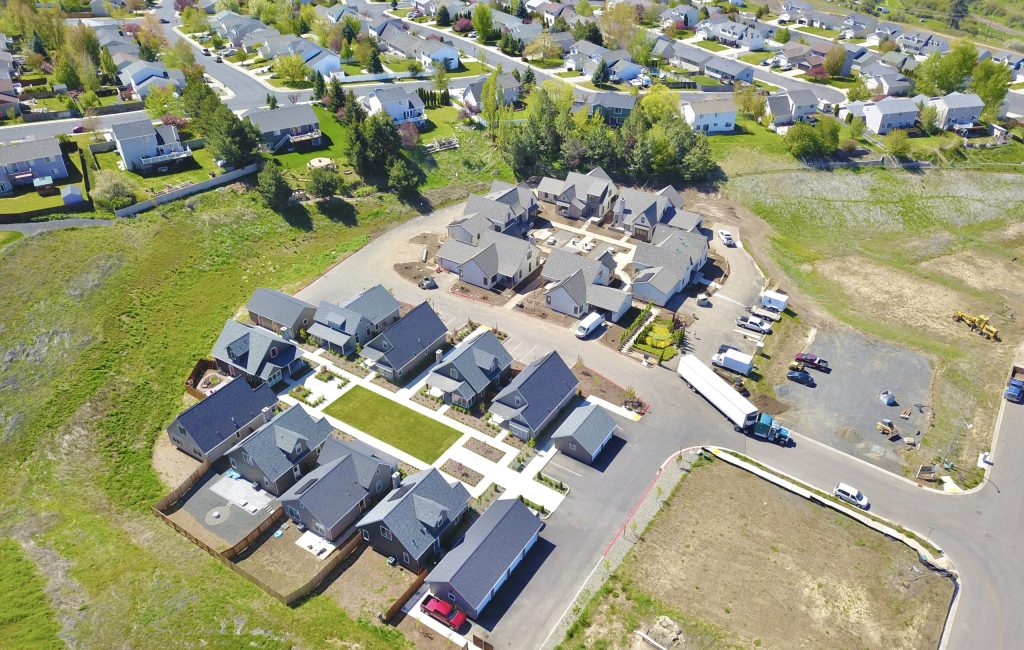The Community
Hiddenview is a thoughtfully designed pocket neighborhood in Pullman, WA, the heart of Washington’s beautiful Palouse region. This small-scale community of 6 homes and 9 cottages, each clustered around a commonly shared lawn and courtyard, provides a refuge of peace and human-scale interaction rarely found in today’s suburbs and large-scale world. The beautiful architecture and intimate neighborly atmosphere fosters a strong sense of belonging to its residents.
Pocket neighborhoods, like Hiddenview, prioritize human-scale environments, typically a central shared space around which the homes are arranged. This design promotes a sense of safety, shared responsibility, and communal living, making it an ideal environment for families, young couples, and empty nesters alike.This small-scale community design offers functions of society that we so often miss in today’s built environment, like the ability to know your neighbors. Here there is always a helping hand nearby, and that can never be a bad thing.
This award-winning neighborhood stands as a one-of-a-kind development in Pullman, WA, offering residents a harmonious blend of privacy, community, and convenience. Hiddenview is not just a place to live but a place to thrive, fostering meaningful connections and a high quality of life.
WHAT IS A POCKET NEIGHBORHOOD?
Hiddenview is referred to as a “pocket neighborhood”. Pocket neighborhoods are clustered groups of neighboring houses gathered around a shared lawn or courtyard all of which have a clear sense of privacy but also shared stewardship.
These settings foster a strong sense of community and neighborly atmosphere which is far to foreign in today’s suburbs. These are human-scale settings where neighbors can easily know one another and a helping hand is always nearby.
They are simple.
They are peaceful.
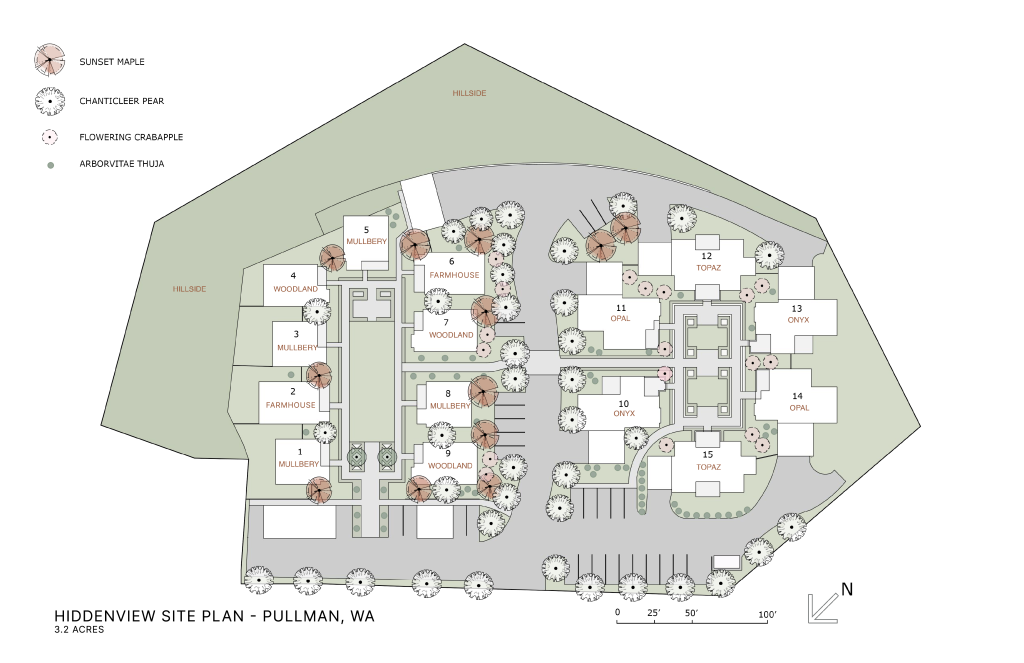
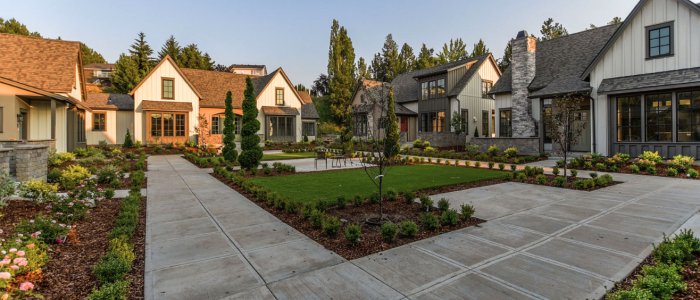
THE IMPACT OF SHARED SPACE
The public common area at the center of these pocket neighborhoods is important and fosters a sense of shared responsibility among the residents.
The neighborhood has clearly defined boundaries and these layers of separation of separation simultaneously provide privacy for homeowners while also allowing for community to develop through the nodding hello’s, passing ‘good mornings’, and impromptu porch conversations that turn into real relationships.
WHAT DO YOU MEAN WHEN YOU SAY HUMAN SCALE?
When we speak of “human scale,” we refer to a principle that places the human experience and prioritizes the comfort, convenience, and well-being of people, rather than vehicles or large-scale infrastructure.
Our world has been developed by civil engineers and generic blueprint plans that are slapped down onto one-size-fits-all lots. High-speed roads sprawl and cut through neighborhoods, idolizing the car above all else. We believe that this way of development is anti-human. As a society, we develop and build with standards and specifications that are not conducive to how humans move, live, and thrive. As the great Christopher Alexander poignantly noted,
“Placed and built anonymously, [suburban] houses express isolation, lack of relationship, and fail altogether to help create human bonds in which people feel themselves part of the fabric which connects them to their fellow men.”
Buildings, when crafted with an eye for human scale, should not tower over us with an impersonal might. Instead, they stand at heights that are comforting and relatable, creating a skyline that feels both intimate and inviting. Public spaces such as plazas and courtyards should beckon us to gather and converse. These spaces, when crafted with intention, become the bedrock of our communities and speak to something deep within us. This is all done through the choice of materials, the harmony of colors, and the timelessness of architectural forms. These elements coalesce to create places that feel inherently “right”, as if they have always belonged.
When we embrace human scale, we create spaces that are not just physically accommodating but spiritually fulfilling. These environments foster a profound sense of community, belonging, and well-being.

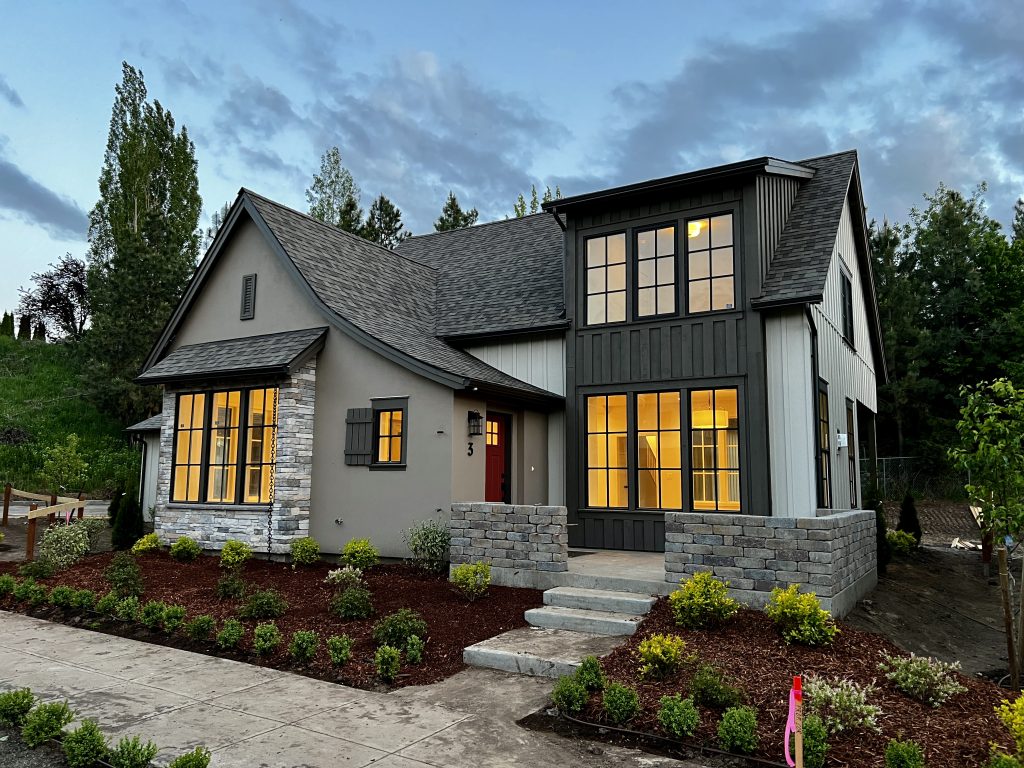
WHY DOES GOOD ARCHITECTURE MATTER?
Beautiful architecture matters because it impacts our emotional well-being by uplifting our spirit and giving ourselves a sense of identity. Mass housing can provide a high standard of living but it does not provide quality of life. It doesn’t provide the intangible things that we need and value as human beings; the sense of identity and belonging. At its core, beautiful architecture connects us to our environment, creating spaces that are not only functional but also inspiring.
Architecture is the only form of art in which we live. This type of interaction with our surroundings has profound effects on your emotions and sense of being. We want to build homes and neighborhoods that will stand the test of time, becoming a lasting legacy for future generations.
In essence, good architecture is not just about aesthetics; it is about creating environments that enrich our lives.
WHY FRONT PORCHES?
Front Porches are an easy design element to look at in how it contributes towards community-oriented design. Porches, something that used to be so common have been shuffled to the side or altogether lost in the dominance of garage-faced homes. But within a well-designed neighborhood, porches can play a crucial role by serving as transitional spaces between the private interior of a home and the public realm of the street or neighborhood.
These transitional spaces act as buffers between the private and public realms, providing semi-private areas where residents can enjoy the outdoors while still feeling a sense of privacy and security. Porches can create opportunities for spontaneous social interactions among neighbors. Sitting on a porch allows residents to engage in casual conversations with people passing by, fostering a sense of community and strengthening social bonds. Finally, porches increase “eyes on the street,” enhancing neighborhood safety by creating a sense of surveillance that can deter crime and encourage safer, more welcoming streets.
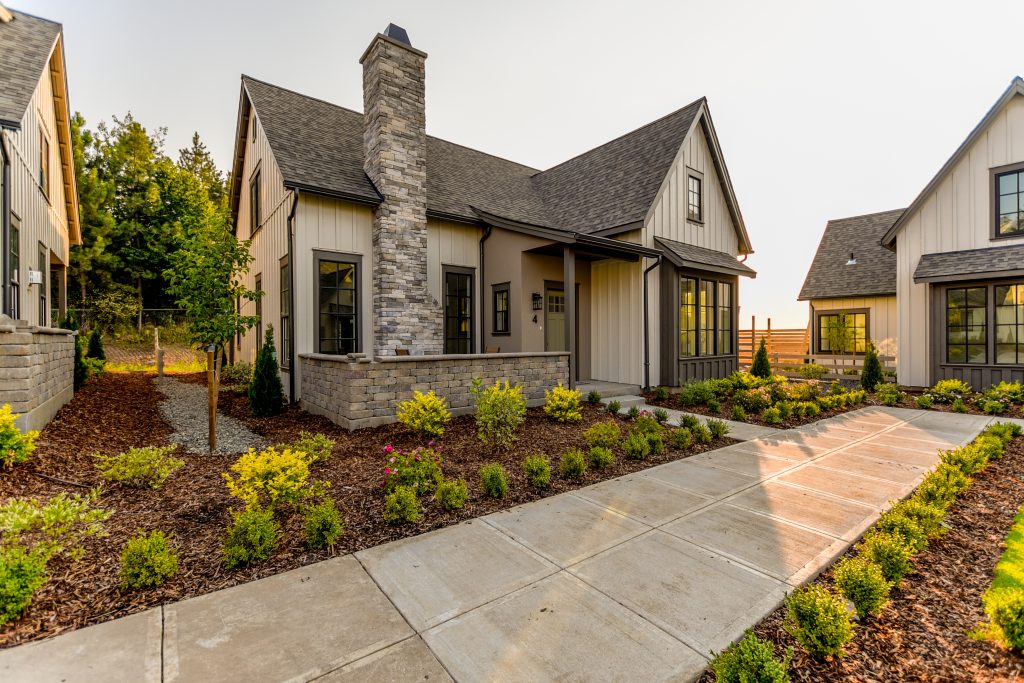
HOW ARE POCKET NEIGHBORHOODS DIFFERENT THAN CONVENTIONAL NEIGHBORHOODS?
Pocket neighborhoods emerge as havens of human connection, distinct from the sprawling anonymity of conventional neighborhoods. In the vast expanse of conventional neighborhoods, several hundred households are loosely bound by a network of streets without any real sense of community. Within this broader expanse, a pocket neighborhood reveals a different pattern, prioritizing human-scale living and a sense of belonging among residents. The beauty of pocket neighborhoods lies not just in their design, but in the life they enable. They stand as a testament to the timeless way of building, where architecture serves the deeper purpose of fostering human connection.
